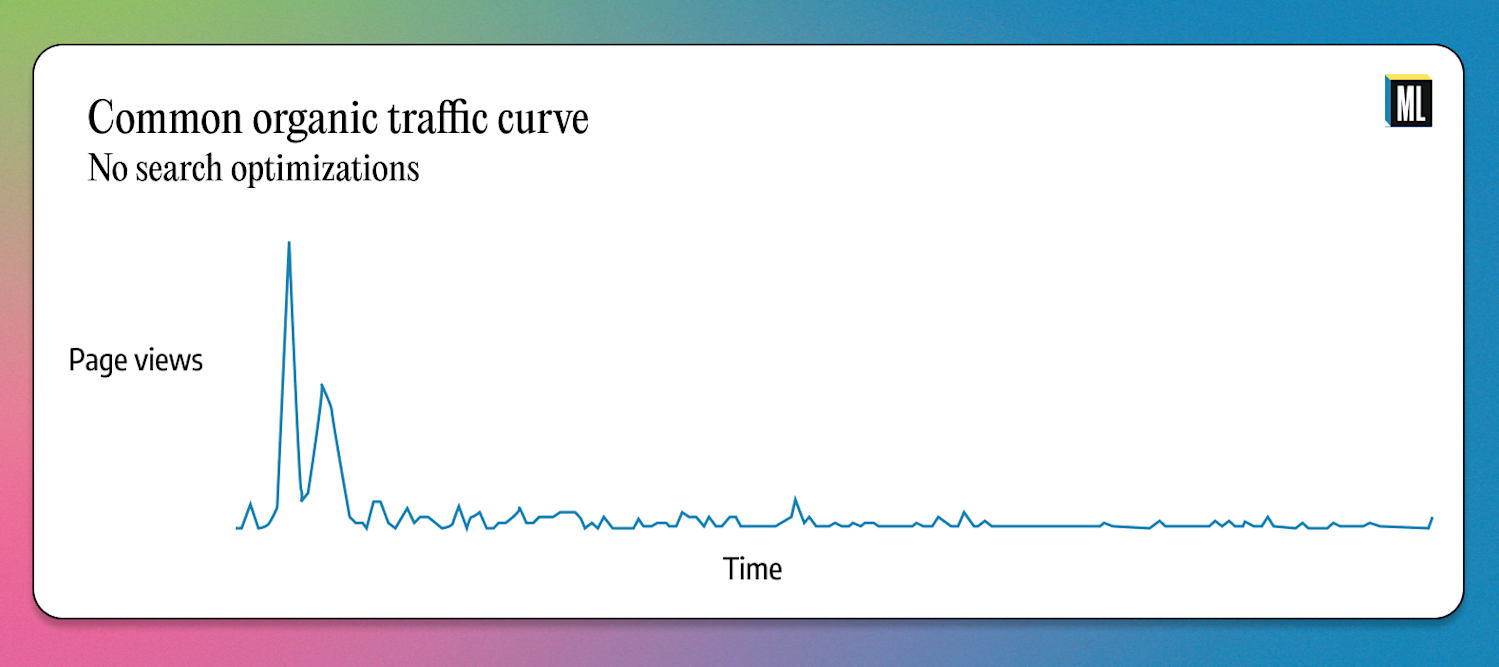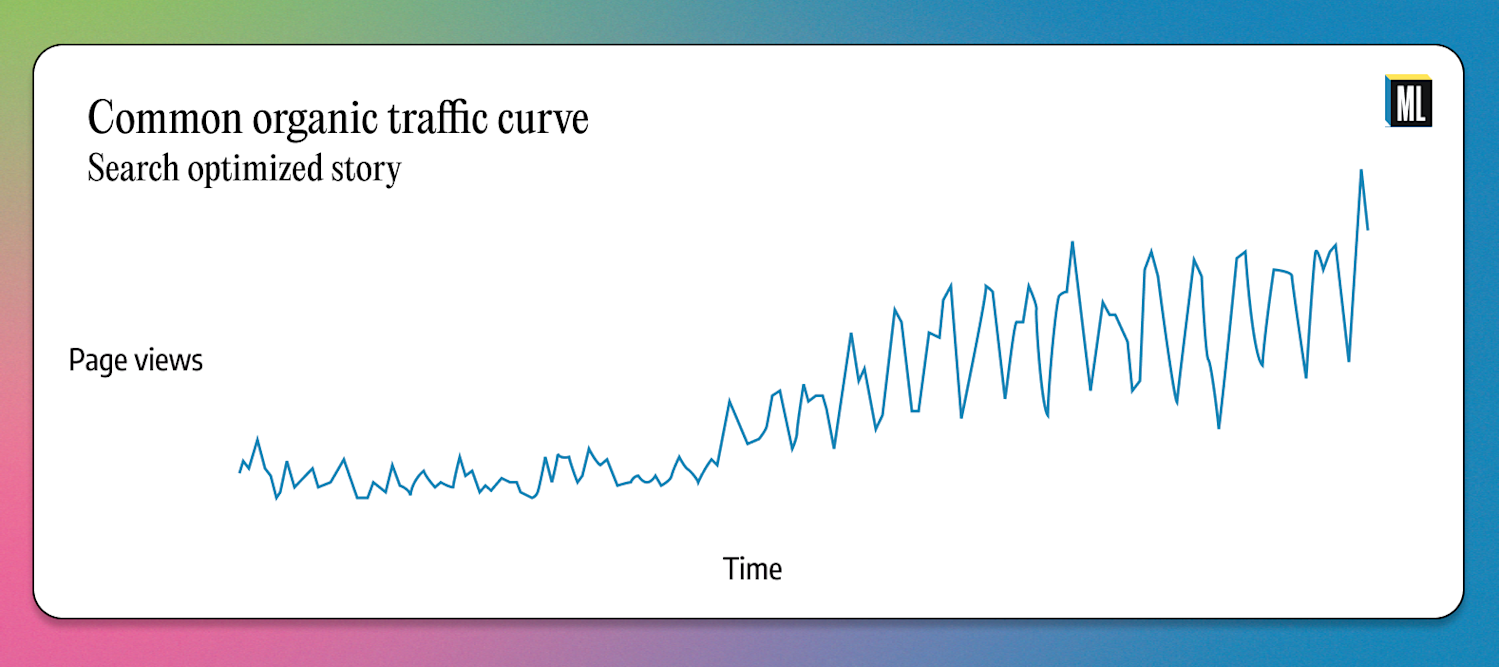
Live long to prosper: Longevity and the value of content
Content only creates value when it’s seen. Here’s how to get it seen more — and for longer
It’s painful to put a ton of effort into a story only to watch it get a few pageviews for a couple weeks, and then slide into digital obscurity, never to be read again.
That happens more often than anyone who’s taking the time to research, find sources, write, edit, iterate and relentlessly revise would like. But most content, regardless of format, has a short life. The vast majority of articles get 80% of their lifetime pageviews in the first week after they’ve been published, according to Chartbeat. While our own research points to a slightly longer moment in the sun — around 90-days for non-news editorial content — even this window of visibility is still painfully brief.
What if it didn’t have to be? With intentional strategy, it’s possible to extend the value horizon of a story long past the 90-day mark. Even, in some cases, indefinitely. Here’s how.
Understand what makes content valuable
Let’s first get clear on what “content value” means. At Message Lab, we believe that content is valuable when it drives action.
For consumer brands, driving action means purchases. But that’s not the case for everyone. Some organizations sell ideas. Others have big and expensive products, with extended buying journeys. That makes quantifying the value of content more challenging, since there isn’t a clear, direct line between publishing and revenue. So in cases when we can’t lean on dollar sign metrics, we can shift to focus on measuring content’s ability to influence behavior. And that can be tracked just as tangibly as any revenue metric.
Our clients often tell us: “I want to grow awareness of my brand.” While there’s no such thing as an awareness metric in Google Analytics, we can break down “awareness” into a pattern of behavior. It’s an important step because converting conceptual goals into specific behaviors makes them trackable.
Thus, somebody who is more aware of my brand:
is more likely to visit (and revisit) my site
spends more time on each visit
shares my content with their friends on LinkedIn
signs up for my newsletter
All of these behaviors can be measured. Thus, they can more easily be connected to content.
Numbers that aren't tied to behaviors are just numbers. They represent value, but are not inherently valuable.
But we frequently see publishers get ahead of themselves by focusing on metrics, like pageviews and bounce rates, without first thinking about the behaviors they want the audience to take. This is a pitfall, because while the classical suite of publishing KPIs is important, numbers that aren’t tied to behaviors are just numbers. They represent value, but are not inherently valuable.
Make your content more effective
Valuable content is effective at encouraging desirable actions and behaviors. But you can’t just publish any content and expect crowds to magically appear on your site, engage with your content, share it with their networks, and sign up for your newsletter.
Every facet of your content has to be intentionally optimized towards these behaviors. Here’s how we do it.
Quality: If you want people to internalize your ideas, they need to read your content. Formats that include thoughtful, well-written features, rigorously reported stories backed by data, and Q&As with leading voices in your field will get you part way there. Presentation also matters. So put the reader's experience first (for guidance on how and why, check out our Perfect Article Template). Write clear and descriptive headings and subheads, and pick the right visuals.
Findability: Your pieces must be easy to find and easy to share. That means creating clear pathways to and from stories, and promoting them intentionally and often, across all your channels.
Measurability: Readers’ wants and interests change, and you need the ability to change with them. Data can tell you when it’s time to write more of something, or when to adjust your editorial calendar. This also requires setting up infrastructure to monitor and measure the performance of your stories.

Search as a fountain of youth
Content can only drive value when it’s seen. That’s why the pageview will always remain important. But after you’ve created valuable content, you’ll need to think about extending its visibility. Now, one way to do that is to publish constantly: be on top of every story, speak to every trend, and work 24/7 so that your content pipeline is always full. But unless you’re a news organization, that sort of pace probably isn’t for you.
What you should do instead is manipulate time – or more precisely, your content’s ability to withstand it. You can do that by capitalizing on organic search.
We don’t think search will be replaced by AI anytime soon. AI will, however, raise the bar on how good your content needs to be to get noticed. That’s good news: search is your temporally agnostic gateway to the widest possible audience.
We typically see organizations promoting new content by publishing it on their website, posting about it on social media, and sometimes highlighting it through partnerships like earned media and coordinated peer promotions. But this promotion model will always be constrained by the size of your site readership and social following. On top of that, the velocity of social media means that an average post can hope for a few days of visibility before it gets painted over with newer content. That’s why the traffic trend for most pieces of content looks like this:

By contrast, search can give you access to the entire world of readers who might be interested in your content and its themes — regardless of their familiarity with your brand. If your story is good and useful, and you rank for the right keywords in search, it can show up indefinitely. That opens potentially limitless opportunities to spread ideas, encourage behaviors and influence readers.
Plus, search can get better with time. If your story shows up for relevant search queries, your content will receive more clicks and traffic over the long term. Other sites might link to you. All these signs will feed back into the search engine and tell it you have a high-quality article. Your ranking will improve. You’ll get more traffic and more links. The flywheel will keep spinning, and you’ll get a traffic trend curve that looks more like this:

Break out of the boom-bust cycle
Without content longevity, you can fall into a boom-bust cycle, where you need each new story to be wildly successful in order to acquire readers and sustain your publishing operation. By contrast, longer-lived stories free you from chasing the back-breaking pace of a news cycle, raise your baseline volume of traffic, and give you some editorial breathing room.
Not every story can, or should, live forever. But you work hard to make good content. Improving lifetime value will make your stories work harder for you.
About the author

Eric Xu
Eric Xu specializes in turning complex data into clear, actionable insights that inform digital communications strategies. With a sharp eye for patterns and a knack for storytelling, he helps brands uncover the narratives hidden in both quantitative and qualitative research. At Orchestra, he supports a wide range of client programs by surfacing insights that demonstrate impact and reveal opportunities for optimization. He has worked across industries including nonprofit, venture capital, higher education, and tech. Before joining Orchestra, Eric worked in B2B enterprise software operations, local journalism, and museum exhibit planning — an eclectic path that informs his multidisciplinary approach to strategy. He holds a master’s degree from Northwestern University’s Medill School of Journalism and is based in the Washington, DC, area. Outside of work, you can find him road-tripping, taking photos, or passionately debating the merits of pour-over vs. espresso.


